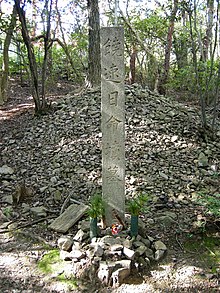User:Immanuelle/Nigihayahi
| This user page or section is currently being expanded by an editor. You are welcome to help in expanding too. If this page has not been changed in several days, please remove this template. This page was last edited by Immanuelle (talk | contribs) 23 hours ago. |
This article may be expanded with text translated from the corresponding article in Japanese. Click [show] for important translation instructions.
|
| Immanuelle/Nigihayahi | |
|---|---|
 Tomb of Nigihayahi | |
| Personal information | |
| Parents |
|
| The English used in this user page may not be easy for everybody to understand. You can help Wikipedia by reading Wikipedia:How to write Simple English pages, then simplifying the page. |
| This is a draft being worked on by Immanuelle. It is too complex at the moment but she wants to get it ready to be an article someday. Others are free to edit it This page was last edited by Immanuelle (talk | contribs) 23 hours ago. |
Nigihayahi is a Japanese deity.[1] mentioned in the Kojiki, Kujiki, and Nihon Shoki[2]
He was involved with the Tenson Korin.[3] The Mononobe clan claimed him as their ancestor.[4]
In the Kujiki, Amenohoakari is considered the same kami as Nigihayahi, the ancestral god of the Hozumi and Mononobe clans, but this contradicts their generational relationships and areas of activity.[5]
He is sometimes described as the older brother of Ninigi[6], or the son of Ame-no-oshihomimi.[1]
The nature of the deity and its myths in the Kojiki, Kujiki, and Nihon Shoki all suggest a possible Korean influence.[2]
Jimmu's Eastern Expedition[change | change source]
During Jimmu's Eastern Expedition Jimmu and his brothers reached Naniwa (modern-day Osaka), they encountered another local chieftain, Nagasunehiko ("the long-legged man"), and Itsuse was killed in the ensuing battle[7][8] .[9][10][11][12][13][14] Nagasunehiko claimed to follow Nigihayahi.[1][14] Jimmu realized that they had been defeated because they battled eastward against the sun, so he decided to land on the east side of Kii Peninsula and to battle westward. They reached Kumano, and, with the guidance of a three-legged crow, Yatagarasu ("eight-span crow"), they moved to Yamato. There, they once again battled Nagasunehiko and were victorious.[15] Nigihayahi killed Nagasunehiko and submitted to Jimmu.[1][14]
In Yamato, Nigihayahi, who also claimed descent from the Takamagahara gods, was protected by Nagasunehiko. However, when Nigihayahi met Jimmu, he accepted Jimmu's legitimacy. At this point, Jimmu is said to have ascended to the throne of Japan.[16]
In popular culture[change | change source]
He is present in Ghost of Tsushima.[17]
References[change | change source]
- ↑ 1.0 1.1 1.2 1.3 1.4 "Nigihayahi | 國學院大學デジタルミュージアム". 2023-03-21. Archived from the original on 2023-03-21. Retrieved 2023-12-05.
- ↑ 2.0 2.1 Como, Michael (2009-09-02). Weaving and Binding: Immigrant Gods and Female Immortals in Ancient Japan. University of Hawaii Press. ISBN 978-0-8248-2957-5.
- ↑ Satomi, Kishio (2013-07-04). Discovery of Japanese Idealism. Routledge. ISBN 978-1-136-39365-5.
- ↑ Cali, Joseph; Dougill, John (2012-11-30). Shinto Shrines: A Guide to the Sacred Sites of Japan's Ancient Religion. University of Hawaii Press. ISBN 978-0-8248-3775-4.
- ↑ Hoga, Toshio (2007). Shoki Mononobe-uji no Keifu (1) Kokigi no Heya (初期物部氏の系譜 (1) 古樹紀之房間). Japan.
{{cite book}}: CS1 maint: location missing publisher (link) - ↑ Barnes, Gina (2007-03-12). State Formation in Japan: Emergence of a 4th-Century Ruling Elite. Routledge. ISBN 978-1-134-38469-3.
- ↑ Bunko (Japan), Tōyō (1975). Memoirs of the Research Department.
- ↑ "Kamuyamatoiwarebiko | 國學院大學デジタルミュージアム". 2023-03-21. Archived from the original on 2023-03-21. Retrieved 2023-11-23.
- ↑ Monbushō, Japan; Brinkley, Frank (1893). History of the Empire of Japan. Dai Nippon Tosho Kabushiki Kwaisha, by order of the Department of Education. Printed at the Japan Mail Office, Yokohama.
- ↑ Roberts, Jeremy (2009). Japanese Mythology A to Z. Infobase Publishing. ISBN 978-1-4381-2802-3.
- ↑ Anonymous (2023-09-29). The Great Events: Vol. 1. BoD – Books on Demand. ISBN 978-3-368-19823-7.
- ↑ Weiss, David (2022-01-13). The God Susanoo and Korea in Japan's Cultural Memory: Ancient Myths and Modern Empire. Bloomsbury Publishing. ISBN 978-1-350-27119-7.
- ↑ James, David H. (2010-11-01). The Rise and Fall of the Japanese Empire. Routledge. ISBN 978-1-136-92547-4.
- ↑ 14.0 14.1 14.2 Various (2022-09-16). Japan: From the Japanese Government History. DigiCat.
- ↑ 朝廷軍の侵略に抵抗 (in Japanese). Iwate Nippo. September 24, 2004. Archived from the original on March 3, 2016. Retrieved March 1, 2011.
- ↑ メンテナンス中
- ↑ "Charm Of Nigihayahi-No-Mikoto - Location & Effects | Ghost Of Tsushima". GameWith. 2022-08-21. Retrieved 2023-12-05.

